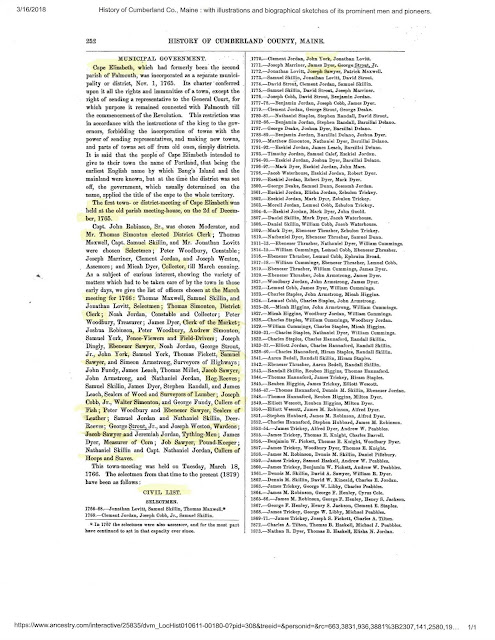Though the focus of this blog is to recover a fragment of the stories of those souls interred at the East Deering/Grand Trunk Cemetery, I will take some time to share what I hope will be beneficial to others who are interested in genealogical sleuthing. Many may be in pursuit of information about other branches of the James Sawyer family tree.
The early history of the ancient town of Falmouth, which encompassed Cape Elizabeth and South Portland (Spurwink and Purpoodock) contains information that acknowledges that John Sawyer and his brother, Jacob were inhabitants of this area of the settlement. From James Babson's History of Cape Ann, and William Willis's History of Portland, I have found evidence which I will share here.
As we learned, John Sawyer was admitted as a proprietor of Famouth early on, about 1720. He was instrumental, along with others, in building the first meeting house and acquiring the first settled minister, The Rev. Thomas Smith for the infant settlement.
In 1726, the town voted to supply Rev. Mr. Smith with firewood, "during his continuance as our minister." At the same meeting, arrangements were made for Mr. Smith's ordination. A vote was passed desiring Maj. Moody to entertain the minister and messengers, and that John Sawyer be desired to take care of their horses. Sawyer lived on Purpoodock side, where they were to leave their horses, which saved the ferrying over. They all came from the west to the ferry at Purpoodock side.
Portland In The Past by William Goold, pgs. 282 - 283
The total population of Falmouth in 1725, was forty-five families including seventeen families who resided in Purpoodock and Spurwink. Traveling back and forth to attend church services was a burden, so the residents built a log house which served both as a garrison for their protection and a meeting house where the whole village could assemble. Goold records:
The people at Purpoodock had also a log house on the Point, which they built partly for a meeting house, in which the whole town assembled every third Sabbath. The log meeting house and garrison were on the rising ground in the rear of Fort Preble point; Spring Point.
Goold goes on to record that the graveyard adjoined the meeting house,
sometimes the sea encroached, letting down many graves and lettered stones, where were buried the Simontons, Whites, and others, the first settlers.
Concern for the safety of the inhabitants of the town of Falmouth was real. Although hostilities had lessened after the Treaty of 1713, there was evidence that invasions were still probable. Finally, the petitions of the inhabitants were heeded by the governing body in Massachusetts, and soldiers were assigned to the various garrisons in the town for their defense.
William Willis records:
January 1723, soldiers were stationed in Falmouth as follows: on the Neck, twenty - four men in three garrisons, viz., at Major Moody's, Ingersoll's, and Wass's; in Purpoodock at Sawyer's, and at York's, four men and a corporal, at Spurwink, at Mr. Jordan's where a ferry is kept, three men under the care of a corporal.Undoubtedly, the job of ministering to the spiritual needs of the infant settlement, scattered in such an extensive geographic area, had to be very challenging for the Rev. Smith. He performed this duty for many years.
Remember that the town of Falmouth,during this era encompassed what are today's Portland, Cape Elizabeth, South Portland, Westbrook and today's town of Falmouth. Rev. Smith's ministry was not just to care for the spiritual needs of his flock. Oftenhe would find that he needed to offer help for their sicknesses. Since medical doctors were rare, the Rev. Smith, would often be their only source of health care. He also attended to the dying which he often records in his journal.
For this next section, I will share some of the research material that I found in hopes that those who read this blog will be inspired to pursue their own inclinations and direction in wanting to know more about the Sawyer brothers.
 |
| These gravestones were carved in Boston and are in remarkable condition. |
 |
| Rebeckah Sawyer's Memorial |
John Sawyer was about 43 years old when he immigrated to Falmouth. Eight of his children were born in Cape Ann. Only his daughter Bethiah Sawyer was born in Falmouth. John Sawyer died in 1760 at he age of eighty-four, and from was laid to rest at the Meeting House Hill/Mt. Pleasant Cemetery. You will note that the spouses of his children are names that we still recognize today, and are associated with the history of Cape Elizabeth: Skilling, Strout and Jordan.
It is clear from reading the final disposition of his estate, that John Sawyer was highly regarded by his children, as they refer to him as our 'honored father'.
Jacob Sawyer died at the age of eighty, but I could not find a record of his burial. I hope that someone else has better luck. Here is a copy of the final settlement of his estate listing the names of his children and dated April 8, 1767.
I am also including the following from the town's account of municipal jobs important to run the government of the day. You will note some mention the Sawyer's and their relatives.
I am ending this account of the Sawyer brothers, John and Jacob here. Although I could have spent much more time on this interesting bit of history, I meed to get back to the task at hand of looking more closely at Isaac Sawyer.
I hope that others who are so inclined, will share their own research with us. I finalize this piece with a photo. I found a picture of the house in West Gloucester where James Sawyer, the father of John, Isaac, Sr., and Jacob Sawyer resided until his death on May 30, 1703. His legacy shaped both the history of Cape Ann and through his sons, the state of Maine.
























